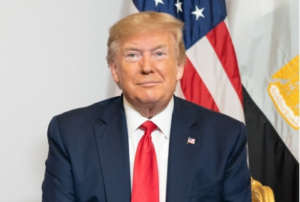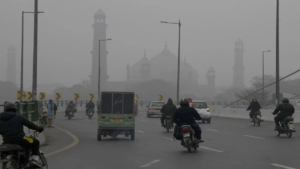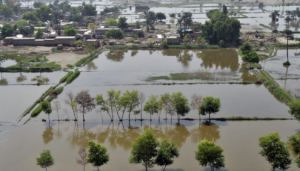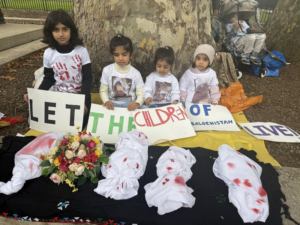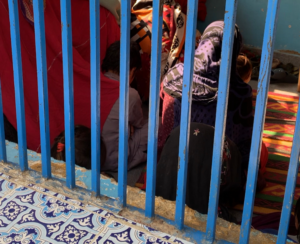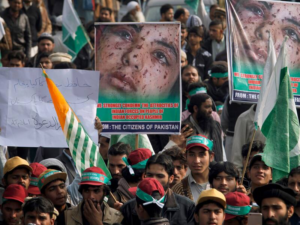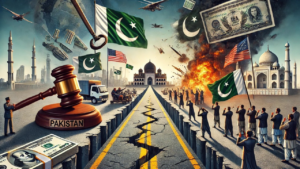
On 17 September 2001, days after horrific terrorist attacks had hit the nation, George W Bush paid a well-publicized visit to the Islamic Center of Washington. At the time, vigilante violence was raining hard on Muslims and Sikhs around the country, with hate crimes already numbering in the hundreds. These included brutal physical assaults, several mosque burnings and at least two murders.
Bush came to the Washington mosque, it has often been reported, to stem the spread of such hate, and over the years Bush’s visit has been repeatedly invoked with near mystical reverence. In 2002, the New York Times called the visit “another anniversary worth honoring”. In 2016, Foreign Policy magazine labeled it “a show of leadership and support for tolerance”. In 2020, a former aide in Bush’s White House, writing on NBCNews.com, described it as a moment of “solidarity with Muslim Americans”.
To be Muslim in America is to see a distorted version of yourself constantly reflected back for purposes you very often don’t agree with
The event is seen not only as an example of Bush’s compassionate side but also as a notable expression of American inclusivity at a time of crisis.
But if everyone seems to recall Bush saying “Islam is peace” at the Washington mosque, how many remember that his administration had already begun rounding up and detaining hundreds, if not thousands, of Muslim immigrants, often in extremely harsh and abusive conditions? How many recollect the hotline the FBI established immediately following the September 11 attacks which received more than 96,000 tips in its first week?
I was living in New York City at the time, residing in the United States on a work visa, and I vividly remember the panic and anxiety that so many of us had that any random stop by the authorities would lead to our detention and deportation. The government wasn’t even releasing the names of the people they arrested. That’s how bad it was.
In this environment, stories spread quickly, such as the true story of the Egyptian man who was charged with trespassing in the very hotel where he was staying and deported. We quickly learned to keep our heads low to the ground, our accents as inaudible as possible, our cabs and corner stores wallpapered in American flags.
In this context, which version of George W Bush should be believed: the president of tenderhearted words about Muslims (“Muslims are doctors, lawyers, law professors, members of the military, entrepreneurs, shopkeepers, moms and dads, and they need to be treated with respect,” he said) or his administration of merciless actions toward the same Muslims?
Facebook Twitter Rana Abdelhamid, a congressional candidate in New York’s 12th district. Photograph: Rana for Congress
The question is larger than Bush and gets at the heart of what being Muslim American has meant for 20 years now, for the “war on terror” depends on these two versions of being Muslim – the exceptional citizen and the dangerous outsider – with both versions needing to exist simultaneously.
And, for two decades, this double image has been our Muslim American dilemma, not just because no other version of being Muslim seems legible to the public – you can be Muslim and oppose both America’s wars and al-Qaida’s terrorism, for example – but also because both versions of being Muslim have been continually co-opted to serve the needs of the “war on terror”.
‘Rebranding’ the United States abroad
Let me put this another way. To be Muslim in America is to see a distorted version of yourself constantly reflected back for purposes you very often don’t agree with. It’s not just me who thinks so. Rana Abdelhamid, who is running as a Justice Democrat against the incumbent Carolyn Maloney in New York’s 12th congressional district, recently tweeted: “I was 9 years old when I watched my Congresswoman wear a burqa in Congress to justify the invasion of Afghanistan.”
They were using specifically tailored images of exceptionally good Muslim American citizens to sell the ‘war on terror’ overseas
Abdelhamid, who at 15 was attacked by a man who tried to rip the hijab off her head (every hijab-wearing Muslim American woman has her post-9/11 story), was referring to the time in 2001 when Maloney donned a blue burqa on the floor of Congress to argue for war. “For the rest of my life, I knew that as a Muslim woman my identity would be weaponized to justify American wars. 20 years of war later, what did we accomplish?” Abdelhamid asked.
The exasperation in her words is both palpable and understandable. Since 2001, our Muslim bodies have repeatedly been put on display in the United States and around the world as sources of fear and wonder, and as fuel for war.
Facebook Twitter Donald Rumsfeld and George W Bush at the Pentagon on the morning of 11 September 2001. Photograph: Rex/Shutterstock
In 2002, for example, the Bush administration hired the Madison Avenue executive Charlotte Beers to “rebrand” the US to Muslims abroad. The thinking here was strikingly simple. If the US could just show the world how the Muslims of America are both thriving and content, then all the noisy complaints about a US-led war on Islam should be silenced. After all, how could anyone reasonably object to a US military invasion if the US had proven itself to be a prosperous, multifaith and multicultural society? (The same thinking was evident when Bush explained the rationale behind the 9/11 attacks as “they hate our freedoms”.)
But it takes a certain type of narcissism mixed with delusion to believe that foreign policy quagmires can be solved by “image” management, and Beers’s $15m Shared Values Initiative resulted in a series of laughably bad videos. Most showed accomplished Muslims describing their American achievements and repeating, almost word for word, how they had never encountered any prejudice in the country. In similar fashion, the state department produced a glossy Arabic-language magazine called Hi! which, incidentally, was forbidden from writing stories that even hinted at US foreign policy.
The image of the treacherous Muslim, dependent as it was on antisemitic tropes, dominated the public’s imagination
These propaganda ventures were doomed from the start. For one thing, they turned a willfully blind eye to the very real violence that was being directed against Muslims in the country. For another, they ignored the fact that US foreign policy had direct and deleterious effects on many Muslim lives overseas, opting instead for a sanitized vision of Muslim American life. Even if these clunky portrayals were as effective as playing golf with a softball, they were still using specifically tailored images of exceptionally good Muslim American citizens to sell the “war on terror” overseas.
Imagined treachery at home
Meanwhile, things were different on the home front. After 9/11, the prevailing image of Muslims made for local consumption was hardly one of happy homemakers in hijabs. Instead, Muslim communities around the country immediately became fifth columnists of the first order. Writing in the New York Post on 20 September 2001, John Podhoretz breathlessly claimed, without providing any evidence, that there was “irrefutable evidence” of “a dangerous and functional foreign-born “fifth column” at work on American soil”. These traitors to civilization were “finding succor”, he wrote, “burrowed inside Arab and Muslim communities in American neighborhoods”.
Facebook Twitter Lena Alfi, her mother, Manal Alfi, and Heba Hathout sing God Bless America on 13 September 2001 in Pasadena, California, at an interfaith memorial service for victims of the 9/11 attacks. Photograph: Lucy Nicholson/AFP
Never mind that this widespread sympathy for al-Qaida was never discovered among Muslim Americans. The image of the treacherous Muslim, dependent as it was on antisemitic tropes (we should note Podhoretz’s rat imagery), dominated the public’s imagination while also sustaining the “war on terror’s” aims from the get-go.
Over the years, our politicians repeatedly returned to the idea that the “war on terror” was necessary to keep the homeland secure from the never-ending and ever-evolving Muslim threat. By 2007, Bush was cynically stating: “We will fight them over there so we do not have to face them in the United States of America,” to loud applause from the American Legion (where exactly is “over there”, anyway?).
Everywhere we went, we were expected to denounce acts we had never endorsed in the first place
Statements such as these always ended up ironically priming the public to find terrorists among the Muslims at home, which is exactly how television shows like 24, Sleeper Cell, and, later, Homeland worked, portraying Muslims almost exclusively as duplicitous and malevolent, unless – and this was key – they worked for the government.
Everywhere we went, we were expected to denounce acts we had never endorsed in the first place. Sometimes, these demands for disavowals bordered on the absurd. Years ago, when I was researching my book How Does It Feel to Be a Problem?, I attended a closed-door meeting between the FBI and local Arab Muslim leaders in Brooklyn. At one point, the high-ranking FBI official running the meeting turned to the imam, the religious leader, among us to ask him “a very difficult question”. If he encountered a fellow imam who was recruiting youth “to go overseas to learn how to carry out jihad,” the official asked, would the imam report him?
This is hardly a difficult question. What was the imam supposed to say in front of seven presumably armed FBI agents? The words were put in his mouth, and he had to say them. For years, the “war on terror” has continued to write the script of what’s allowable for Muslims to think, say and do. Go off script and everyone thinks you’re either a budding radical extremist or, at best, a terrorist sympathizer. In this environment, even non-Muslims would occasionally find themselves having to disavow being Muslim, some tripping up on their own political bigotry while doing so.
Facebook Twitter Barack Obama campaigns at a rally at Ohio State University in Columbus, Ohio, in 2008. Photograph: Paul Vernon/AP
I’m speaking, of course, about Barack Obama. During his presidential campaign of 2008, his official website listed calling the candidate a “Muslim” as a “smear”. Obama himself didn’t help much, either. That duty would fall to Colin Powell, the former secretary of state who during a TV interview plainly stated, “Is there something wrong with being a Muslim in this country? The answer is no.”
‘Muslims were so demonized’: Mehdi Hasan, Zainab Johnson, Keith Ellison and more on 9/11’s aftermath Read more
Obama, on the other hand, sounded like he was testifying in front of the House Un-American Activities Committee when he told a Christian News service in 2008: “I’m not and never have been of the Muslim faith”. People often excused Obama because the association is so radioactive. Imagine, then, actually being Muslim.
The burden of suspicion
And the suspicions have continued, year after year. If we wanted to build a mosque, we would be accused of “creeping sharia”. If we applied for citizenship, our applications would be needlessly delayed or denied. If we carried a paper box on a plane, we would be suspected of hiding a bomb. In one case from 2015, a Southwest Airlines passenger, Maher Khalil, was forced to open the carton in his hands, which revealed a delicious assortment of baklawa. He proceeded to share his pastry with the same belligerent passengers who had demanded his removal. It sounds like a cute story about our cross-cultural love for refined sugar, until you realize that we Muslims are expected to buy off people’s bigotry with whatever we have on our person. Forget feeding intolerance. Why should we be expected to feed the intolerant?
Facebook Twitter Muslim leaders and organizers of over 55 mosques participate in a news conference and protest in New York to defend the presence of mosques in the US on 1 September 2010. Photograph: Spencer Platt/Getty Images
Then there have been the myriad ways the US government has organized law enforcement over the past two decades to find conspiracies hiding under every kufi. And when they haven’t found them, they’ve simply created them. The examples are too many to list, though they come with a kind of institutionalized pattern. Law enforcement recruits questionable informants to set up unsuspecting Muslims in baited terrorism traps. Many of the hapless Muslims ensnared in these schemes are desperately poor and vulnerable while also often living with mental health challenges.
Since 9/11 Muslim Americans have been forging their existence in a national atmosphere that has been hostile more often than hospitable.
Each arrest, routinely and loudly announced by the authorities, has fueled the idea that the US government is hard at work fighting the legions of terrorists on American soil. Yet the vast majority of those arrested over (often flimsy) terrorism-related accusations since 2001 were never even close to committing an act of violence, as the database cataloguing these cases at the Intercept illustrates. And while preventing political violence is a legitimate task for any government, doing so by creating false stories of subterfuge not only fuels racism at home and abroad but also takes away resources from investigations of real threats.
The case of Hamid Hayat is worth remembering. Hayat was born in the United States in 1982 and lived in Pakistan from age seven to 18. A severe bout with meningitis in 2000 left him cognitively impaired, and he returned to the United States that year. He was working as a cherry picker in Lodi, California, when an FBI informant, Naseem Khan, befriended him. (Khan would be paid over $200,000 for his efforts.) Khan spun tales about Hayat to the government, and the authorities initially accused Hayat of being part of an al-Qaida sleeper cell. Eventually, he was charged with plotting an attack in the United States and of having attended a terrorist training camp in Pakistan.
Facebook Twitter Hamid Hayat, right, is welcomed by the community after making his first public appearance at a news conference that coincided with Eid al-Adha in Sacramento, California, in 2019. Photograph: Daniel Kim/AP
Much of the trial centered around a piece of paper found in Hayat’s wallet. Prosecutors, and their expert witness, said the paper proved that the young man was a jihadist, but all that was on the paper was a relatively common Muslim prayer that the prosecution of course interpreted as sinister. This wasn’t guilt by association. It was more like conviction by mistranslation. In 2006, Hayat was found guilty and sentenced to 24 years in prison.
Then, years later, a journalism student at the University of California, Berkeley, began looking seriously into the case. That training camp Hayat was said to have attended? Sources indicate it wasn’t operative at the time. Witnesses could also account for the period he was supposed to have been away shooting rifles and setting off bombs. Faced with new evidence, the judge vacated Hayat’s conviction in 2019, and the government finally dropped the case entirely in 2020. Meanwhile, Hayat had lost 14 years of his life in prison.
After 20 years of warfare, every American should be asking the same, fundamental question: what has it all been for?
Hayat’s story demonstrates how institutionalized Islamophobia has the power to destroy innocent people’s lives. This situation has been a 20-year reality for Muslim Americans, who since 9/11 have been forging their existence in a national atmosphere that has been hostile more often than hospitable. There have been some key exceptions, of course, such as when thousands of people rushed to airports across the country in early 2017, protesting against the first version of Donald Trump’s travel ban and protecting newly arrived Muslims. We learned something important that day. Hope may be found in the defense of one’s neighbors, but true hope is discovered in the defense of the stranger.
Confronting the past
So how can we all keep this kind of hope – and, with it, more innocent people – alive? A start would be by confronting the colossal failure that is the “war on terror” itself. After 20 years of warfare, every American should be asking the same, fundamental question: what has it all been for? Trillions of dollars have been squandered in bloated military budgets, hundreds of thousands of people killed, whole societies destroyed, uprooted and displaced. What has this global war wrought but more misery, more destruction, and more political violence everywhere it has landed? And over the last two decades, as Muslim Americans know, the dehumanizing logic of war has also extended into our domestic sphere, damaging us deeply from within.
Facebook Twitter ‘Anniversaries typically offer not just moments to reflect on the past but also opportunities for thinking about what lies ahead.’ Photograph: Gary Hershorn/Getty Images
Anniversaries typically offer not just moments to reflect on the past but also opportunities for thinking about what lies ahead. To that end, we can – and should – remember all the victims of 9/11 and every innocent person who has been killed in the “war on terror” since. But now, two decades and so many lost lives later, will we also marshal our capacity to conceive of and work toward a more just, more equitable and more peaceful world? I surely hope so. It seems like no exaggeration to say that our collective future depends on it.
Join Moustafa Bayoumi and the Guardian’s Johana Bhuiyan with Naz Ahmad and Dr Debbie Almontaser in the livestreamed event on what has changed for Muslim Americans in the 20 years since 9/11 on Thursday 16 September 2021 at 3pm EDT | 12pm PDT | 8pm BST | 9pm CEST. Book tickets here

